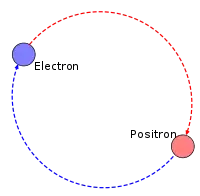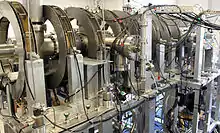Positronium
Positronium (Ps) is a system consisting of an electron and its anti-particle, a positron, bound together into an exotic atom, specifically an onium. The system is unstable: the two particles annihilate each other to predominantly produce two or three gamma-rays, depending on the relative spin states. The energy levels of the two particles are similar to that of the hydrogen atom (which is a bound state of a proton and an electron). However, because of the reduced mass, the frequencies of the spectral lines are less than half of those for the corresponding hydrogen lines.

States
The mass of positronium is 1.022 MeV, which is twice the electron mass minus the binding energy of a few eV. The lowest energy orbital state of positronium is 1S, and like with hydrogen, it has a hyperfine structure arising from the relative orientations of the spins of the electron and the positron.
The singlet state, 1
S
0, with antiparallel spins (S = 0, Ms = 0) is known as para-positronium (p-Ps). It has a mean lifetime of 0.12 ns and decays preferentially into two gamma rays with energy of 511 keV each (in the center-of-mass frame). Para-positronium can decay into any even number of photons (2, 4, 6, ...), but the probability quickly decreases with the number: the branching ratio for decay into 4 photons is 1.439(2)×10−6.[1]
Para-positronium lifetime in vacuum is approximately[1]
The triplet states, 3S1, with parallel spins (S = 1, Ms = −1, 0, 1) are known as ortho-positronium (o-Ps), and have an energy that is approximately 0.001 eV higher than the singlet.[1] These states have a mean lifetime of 142.05±0.02 ns,[2] and the leading decay is three gammas. Other modes of decay are negligible; for instance, the five-photons mode has branching ratio of ≈10−6.[3]
Ortho-positronium lifetime in vacuum can be calculated approximately as:[1]
However more accurate calculations with corrections to O(α²) yield a value of 7.040 μs−1 for the decay rate, corresponding to a lifetime of 142 ns.[4][5]
Positronium in the 2S state is metastable having a lifetime of 1100 ns against annihilation.[6] The positronium created in such an excited state will quickly cascade down to the ground state, where annihilation will occur more quickly.
Measurements
Measurements of these lifetimes and energy levels have been used in precision tests of quantum electrodynamics, confirming quantum electrodynamics (QED) predictions to high precision.[1][7][8]
Annihilation can proceed via a number of channels, each producing gamma rays with total energy of 1022 keV (sum of the electron and positron mass-energy), usually 2 or 3, with up to 5 gamma ray photons recorded from a single annihilation.
The annihilation into a neutrino–antineutrino pair is also possible, but the probability is predicted to be negligible. The branching ratio for o-Ps decay for this channel is 6.2×10−18 (electron neutrino–antineutrino pair) and 9.5×10−21 (for other flavour)[3] in predictions based on the Standard Model, but it can be increased by non-standard neutrino properties, like relatively high magnetic moment. The experimental upper limits on branching ratio for this decay (as well as for a decay into any "invisible" particles) are <4.3×10−7 for p-Ps and <4.2×10−7 for o-Ps.[2]
Energy levels
While precise calculation of positronium energy levels uses the Bethe–Salpeter equation or the Breit equation, the similarity between positronium and hydrogen allows a rough estimate. In this approximation, the energy levels are different because of a different effective mass, m*, in the energy equation (see electron energy levels for a derivation):
where:
- qe is the charge magnitude of the electron (same as the positron),
- h is Planck's constant,
- ε0 is the electric constant (otherwise known as the permittivity of free space),
- μ is the reduced mass:
- where me and mp are, respectively, the mass of the electron and the positron (which are the same by definition as antiparticles).
Thus, for positronium, its reduced mass only differs from the electron by a factor of 2. This causes the energy levels to also roughly be half of what they are for the hydrogen atom.
So finally, the energy levels of positronium are given by
The lowest energy level of positronium (n = 1) is −6.8 eV. The next level is −1.7 eV. The negative sign is a convention that implies a bound state. Positronium can also be considered by a particular form of the two-body Dirac equation; Two particles with a Coulomb interaction can be exactly separated in the (relativistic) center-of-momentum frame and the resulting ground-state energy has been obtained very accurately using finite element methods of Janine Shertzer[9] and confirmed more recently.[10] The Dirac equation whose Hamiltonian comprises two Dirac particles and a static Coulomb potential is not relativistically invariant. But if one adds the 1/c2n (or α2n, where α is the fine-structure constant) terms, where n = 1,2…, then the result is relativistically invariant. Only the leading term is included. The α2 contribution is the Breit term; workers rarely go to α4 because at α3 one has the Lamb shift, which requires quantum electrodynamics.[9]
Formation and decay in materials
After a radioactive atom in a material undergoes a β+ decay (positron emission), the resulting high-energy positron slows down by colliding with atoms, and eventually annihilates with one of the many electrons in the material. It may however first form positronium before the annihilation event. The understanding of this process is of some importance in positron emission tomography. Approximately:[11][12]
- ~60% of positrons will directly annihilate with an electron without forming positronium. The annihilation usually results in two gamma rays. In most cases this direct annihilation occurs only after the positron has lost its excess kinetic energy and has thermalized with the material.
- ~10% of positrons form para-positronium, which then promptly (in ~0.12 ns) decays, usually into two gamma rays.
- ~30% of positrons form ortho-positronium but then annihilate within a few nanoseconds by 'picking off' another nearby electron with opposing spin. This usually produces two gamma rays. During this time, the very lightweight positronium atom exhibits a strong zero-point motion, that exerts a pressure and is able to push out a tiny nanometer-sized bubble in the medium.
- Only ~0.5% of positrons form ortho-positronium that self-decays (usually into three gamma rays). This natural decay rate of ortho-positronium is relatively slow (~140 ns decay lifetime), compared to the aforementioned pick-off process, which is why the three-gamma decay rarely occurs.
History

Stjepan Mohorovičić predicted the existence of positronium in a 1934 article published in Astronomische Nachrichten, in which he called it the "electrum".[13] Other sources credit Carl Anderson as having predicted its existence in 1932 while at Caltech.[14] It was experimentally discovered by Martin Deutsch at MIT in 1951 and became known as positronium.[14] Many subsequent experiments have precisely measured its properties and verified predictions of quantum electrodynamics. There was a discrepancy known as the ortho-positronium lifetime puzzle that persisted for some time, but was eventually resolved with further calculations and measurements.[15] Measurements were in error because of the lifetime measurement of unthermalised positronium, which was only produced at a small rate. This had yielded lifetimes that were too long. Also calculations using relativistic quantum electrodynamics are difficult to perform, so they had been done to only the first order. Corrections that involved higher orders were then calculated in a non-relativistic quantum electrodynamics.[4]
Exotic compounds
Molecular bonding was predicted for positronium.[16] Molecules of positronium hydride (PsH) can be made.[17] Positronium can also form a cyanide and can form bonds with halogens or lithium.[18]
The first observation of di-positronium (Ps2) molecules—molecules consisting of two positronium atoms—was reported on 12 September 2007 by David Cassidy and Allen Mills from University of California, Riverside.[19][20]
Natural occurrence
Positronium in high energy states has been predicted to be the dominant form of atomic matter in the universe in the far future if proton decay occurs. Natural formation of positronium atoms is predicted to begin in about 1085 years.[21] These atoms are postulated to be far larger than the present observable universe, with estimated radii of 1 quintillion parsecs (about 3.1×1034 m).[22] Due to their immense sizes, natural positronium atoms would have very long lifetimes, estimated at 10141 years.[21]
See also
References
- Karshenboim, Savely G. (2003). "Precision Study of Positronium: Testing Bound State QED Theory". International Journal of Modern Physics A [Particles and Fields; Gravitation; Cosmology; Nuclear Physics]. 19 (23): 3879–3896. arXiv:hep-ph/0310099. Bibcode:2004IJMPA..19.3879K. doi:10.1142/S0217751X04020142. S2CID 14848837.
- Badertscher, A.; Crivelli, P.; Fetscher, W.; Gendotti, U.; Gninenko, S. N.; Postoev, V.; Rubbia, A.; Samoylenko, V.; Sillou, D. (2007). "An Improved Limit on Invisible Decays of Positronium". Physical Review D. 75 (3): 032004. arXiv:hep-ex/0609059. Bibcode:2007PhRvD..75c2004B. doi:10.1103/PhysRevD.75.032004. S2CID 9001914.
- Czarnecki, Andrzej; Karshenboim, Savely G. (2000). "Decays of Positronium". In Levchenko, B. B.; Savrin, V. I. (eds.). Proceedings of the International Workshop on High Energy Physics and Quantum Field Theory (QFTHEP). 14. pp. 538–544. arXiv:hep-ph/9911410. Bibcode:1999hep.ph...11410C.
- Kataoka, Y.; Asai, S.; Kobayashi, t. (2009). "First Test of O(α2) Correction of the Orthopositronium Decay Rate" (PDF). Physics Letters B. 671 (2): 219–223. arXiv:0809.1594. Bibcode:2009PhLB..671..219K. doi:10.1016/j.physletb.2008.12.008.
- Adkins, G. S.; Fell, R. N.; Sapirstein, J. (29 May 2000). "Order α2 Corrections to the Decay Rate of Orthopositronium". Physical Review Letters. 84 (22): 5086–5089. arXiv:hep-ph/0003028. Bibcode:2000PhRvL..84.5086A. doi:10.1103/PhysRevLett.84.5086. PMID 10990873. S2CID 1165868.
- Cooke, D. A.; Crivelli, P.; Alnis, J.; Antognini, A.; Brown, B.; Friedreich, S.; Gabard, A.; Haensch, T. W.; Kirch, K.; Rubbia, A.; Vrankovic, V. (2015). "Observation of positronium annihilation in the 2S state: towards a new measurement of the 1S-2S transition frequency". Hyperfine Interact. 233 (1–3): 67–73. arXiv:1503.05755. Bibcode:2015HyInt.233...67C. doi:10.1007/s10751-015-1158-4. S2CID 89605682.
- Rubbia, A. (2004). "Positronium as a probe for new physics beyond the standard model". International Journal of Modern Physics A [Particles and Fields; Gravitation; Cosmology; Nuclear Physics]. 19 (23): 3961–3985. arXiv:hep-ph/0402151. Bibcode:2004IJMPA..19.3961R. CiteSeerX 10.1.1.346.5173. doi:10.1142/S0217751X0402021X. S2CID 119442567.
- Vetter, P.A.; Freedman, S.J. (2002). "Branching-ratio measurements of multiphoton decays of positronium". Physical Review A. 66 (5): 052505. Bibcode:2002PhRvA..66e2505V. doi:10.1103/PhysRevA.66.052505.
- Scott, T.C.; Shertzer, J.; Moore, R.A. (1992). "Accurate finite element solutions of the two-body Dirac equation". Physical Review A. 45 (7): 4393–4398. Bibcode:1992PhRvA..45.4393S. doi:10.1103/PhysRevA.45.4393. PMID 9907514.
- Patterson, Chris W. (2019). "Anomalous states of Positronium". Physical Review A. 100 (6): 062128. arXiv:2004.06108. Bibcode:2019PhRvA.100f2128P. doi:10.1103/PhysRevA.100.062128. S2CID 214017953.
- Harpen, Michael D. (2003). "Positronium: Review of symmetry, conserved quantities and decay for the radiological physicist". Medical Physics. 31 (1): 57–61. doi:10.1118/1.1630494. ISSN 0094-2405.
- Moskal P, Kisielewska D, Curceanu C, Czerwiński E, Dulski K, Gajos A; et al. (2019). "Feasibility study of the positronium imaging with the J-PET tomograph". Phys Med Biol. 64 (5): 055017. doi:10.1088/1361-6560/aafe20. PMID 30641509.CS1 maint: multiple names: authors list (link)
- Mohorovičić, S. (1934). "Möglichkeit neuer Elemente und ihre Bedeutung für die Astrophysik". Astronomische Nachrichten. 253 (4): 93–108. Bibcode:1934AN....253...93M. doi:10.1002/asna.19342530402.
- "Martin Deutsch, MIT physicist who discovered positronium, dies at 85" (Press release). MIT. 2002.
- Dumé, Belle (May 23, 2003). "Positronium puzzle is solved". Physics World.
- Usukura, J.; Varga, K.; Suzuki, Y. (1998). "Signature of the existence of the positronium molecule". Physical Review A. 58 (3): 1918–1931. arXiv:physics/9804023. Bibcode:1998PhRvA..58.1918U. doi:10.1103/PhysRevA.58.1918. S2CID 11941483.
- ""Out of This World" Chemical Compound Observed" (PDF). p. 9. Archived from the original (PDF) on 2009-10-12.
- Saito, Shiro L. (2000). "Is Positronium Hydride Atom or Molecule?". Nuclear Instruments and Methods in Physics Research B. 171 (1–2): 60–66. Bibcode:2000NIMPB.171...60S. doi:10.1016/s0168-583x(00)00005-7.
- Cassidy, D.B.; Mills, A.P. (Jr.) (2007). "The production of molecular positronium". Nature. 449 (7159): 195–197. Bibcode:2007Natur.449..195C. doi:10.1038/nature06094. PMID 17851519. S2CID 11269624. Lay summary.
- "Molecules of positronium observed in the lab for the first time". Physorg.com. Retrieved 2007-09-07.
- Adams, F.C.; Laughlin, G. (1997). "A dying universe: the long-term fate and evolution of astrophysical objects". Reviews of Modern Physics. 69 (2): 337–372. arXiv:astro-ph/9701131. Bibcode:1997RvMP...69..337A. doi:10.1103/RevModPhys.69.337. S2CID 12173790.
- Page, Don N.; McKee, M. Randall (1981). "Matter annihilation in the late universe". Physical Review D. 24 (6): 1458–1469. Bibcode:1981PhRvD..24.1458P. doi:10.1103/PhysRevD.24.1458.
